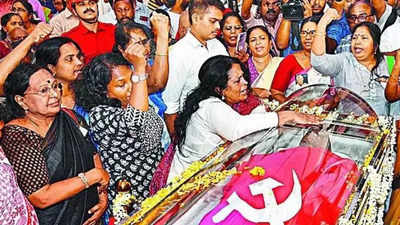This is not a paywall You can keep reading for free! At Hyperallergic , we strive to make art more inclusive, so you’ll never hit a paywall when reading our articles. But, as an independent publication, we rely on readers like you to keep our high-quality coverage free and accessible. Please consider joining us as a member to support independent journalism.
Already a member? Sign in here. We rely on readers like you to fund our journalism. If you value our coverage and want to support more of it, consider supporting us as a member.

Join Us The Noguchi Museum in New York City has terminated three gallery attendants who said they would not comply with a controversial new rule banning staff from wearing the Palestinian headscarves known as keffiyehs . A fourth worker, the director of Visitor Services, was also terminated during the fallout of the policy announcement. On Sunday, September 8, at least 60 people including former workers and supporters protested outside the Queens institution and handed out flyers to inform visitors of the ban, which has been billed by museum leadership as a dress code update prohibiting “political dress” that could make visitors feel “unsafe” or “uncomfortable.
” More than 50 staff members — two-thirds of the workforce — signed an internal petition calling for the policy’s reversal when it was first communicated in late August. “We are gathered here today to mourn a once great museum,” said former Noguchi Museum staffer Trasonia Abbott, addressing the crowd. Abbott worked at the museum for over three years before they were terminated along with fellow gallery attendants Natalie Cappellini and Q.
Chen last week, when they were told that their employment hinged on their observance of a policy they feel is indefensible. Subscribe to our newsletter Get the latest art news, reviews and opinions from Hyperallergic. Daily The latest stories every weekday morning Weekly Editors' picks of the best stories each week Opportunities Monthly list of opportunities for artists, and art workers View our full list of free newsletters .
In a meeting with Director Amy Hao and human resources consultant Eric Perry on September 4, a recording of which was reviewed by Hyperallergic , the three workers were told that they would be sent home with no pay because they were wearing keffiyehs. When Cappellini asked whether “cultural garments” were prohibited, Lorch responded: “Unfortunately, the keffiyeh is also a political symbol, not just cultural.” Staff have largely pushed back against this characterization, arguing that the keffiyeh is a traditional Arab headdress and that in any case, a call for an end to Israel’s bombardment of Gaza is a humanitarian rather than a political cause.
“It’s one thing if I showed up to work wearing Kamala Harris pins. That would be political,” Abbott told Hyperallergic . “But I think that people being murdered in the mass, industrialized way that it’s happening — that’s not political.
” Cappellini also pushed back against the museum’s reasoning, calling the policy a “slippery slope.” “It’s scary to think that anything cultural can be erased on bogus claims of politization,” she said. “What’s next? What’s the next garment that will be seen as too incendiary?” In response to Hyperallergic ‘s most recent request for comment, a spokesperson said the Noguchi Museum could not comment on personnel matters.
In a statement for a previous story, the spokesperson said, “While we understand that the intention behind wearing this garment was to express personal views, we recognize that such expressions can unintentionally alienate segments of our diverse visitorship.” On Sunday, signs with phrases like “Free Palestine” abounded, including one with the words “from the river to the sea” in Japanese and another bearing a message that has been at the heart of workers’ arguments against the new rule: “Noguchi was antifascist.” Currently on view at the museum are works by Isamu Noguchi directly referencing the lethality of the atomic bomb and the artist’s voluntary stay in a Japanese-American internment camp in Arizona during World War II, speakers pointed out on Sunday.
Among them was Riki Eijima, a fourth-generation Japanese American whose ancestors were survivors of the camps; she began her address with a quote by Noguchi describing museums as “a repository against time.” “If this museum wants to live up to its ideals of honoring Noguchi’s legacy and serving the global public, it must respect and affirm its workers’ rights, and ultimately the rights of the Palestinian people,” Eijima said. Some drivers advancing down Vernon Boulevard honked and waved in support, while others voiced criticism.
While one woman stopped to take a flyer and wave her keffiyeh, another man shouted, “Worry about the people in the projects! This has been going on for 4,000 years, so worry about what’s going on here!” (Islamic art scholars such as Stephennie Mulder have argued that this reasoning is factually incorrect and feeds anti-Arab stereotypes.) A bystander named Tom, a middle-aged man who did not provide his last name, told Hyperallergic that he disagreed with the protesters’ views, opining that museums were “places of escape” and that “bringing politics into them is a mistake.” He added that no one could claim to know what Noguchi would have done in this moment, noting that the artist once designed a sculpture garden for the Israel Museum in Jerusalem.
Most of the visitors who stopped to witness yesterday’s demonstration, however, said they were in support of the terminated workers. Former Astoria resident Taylor Buser, an admirer of Noguchi’s works, had just left the galleries when he was met with protesters outside; he told Hyperallergic that the new policy was “extremely shameful.” “If any business wants to live and survive in New York City, which should be a beacon of personal and political and cultural expression, you can’t ban someone’s dress — that’s ridiculous,” Buser said.
Two current Noguchi Museum employees, who spoke to Hyperallergic on condition of anonymity because they feared professional reprisal, independently voiced concerns over “shattered” workplace morale in the wake of a policy that they say has caused “frustration, emotional exhaustion, and a sense of powerlessness among staff.” Further, the way in which dress code update was implemented left more questions than answers, both current and former staff observed, noting that one worker was sent home for wearing a black-and-white scarf that resembled a keffiyeh but did not depict its traditional fishnet pattern. And Abbott, who is Black, said that even though other gallery attendants had worn the keffiyeh before, they were the only one pulled into a private meeting with Hao and an HR representative in a newly acquired property outside the museum’s main building.
“Harmful decision-making has had a destructive impact on the staff at the Museum, and it will be difficult to recover from this and to reestablish trust in leadership,” one worker told Hyperallergic . “While it looks bleak at the moment, I hope there is a path to restoring peace at the Museum through transparency, accountability, empathy and understanding.” Toward the end of the action on Sunday, around 4:30pm, the group circled the museum building in a chorus of collective chanting.
A woman handed out watermelon-flavored lollypops with a QR code linking to a fundraiser for a nurse in Gaza. Rabbi Dovid Feldman of the Neturei Karta anti-Zionist Orthodox Jewish group gave the protesters a wave of solidarity. When asked about her choice to reject the new policy rather than comply and keep her employment, Cappellini said she stood by her decision.
“When Palestinians are silenced all the time in mainstream news, when their perspective is often secondary, when it’s often in the passive voice, wearing a garment that is connected to the culture of Palestinians, that’s beautiful about Palestinian culture — that’s what is valuable to me,” she said. We hope you enjoyed this article! Before you keep reading, we wanted to ask if you would consider supporting Hyperallergic ’s journalism during a time when independent, critical reporting is increasingly scarce. Unlike many in the art world, we are not beholden to large corporations or billionaire board members.
Our journalism is funded by readers like you, ensuring integrity and independence in our coverage. We strive to offer trustworthy perspectives on everything from art history to contemporary art, spotlight artist-led social movements, uncover overlooked stories, and challenge established norms to make art more inclusive and accessible. With your support, we can continue to provide global coverage without the elitism often found in art journalism.
If you can, please consider joining our paid membership program . Millions rely on Hyperallergic for free, reliable information. By becoming a member, you help keep our journalism independent and accessible to all.
Thank you for reading. Share Copied to clipboard Mail Bluesky Threads LinkedIn Facebook.



















